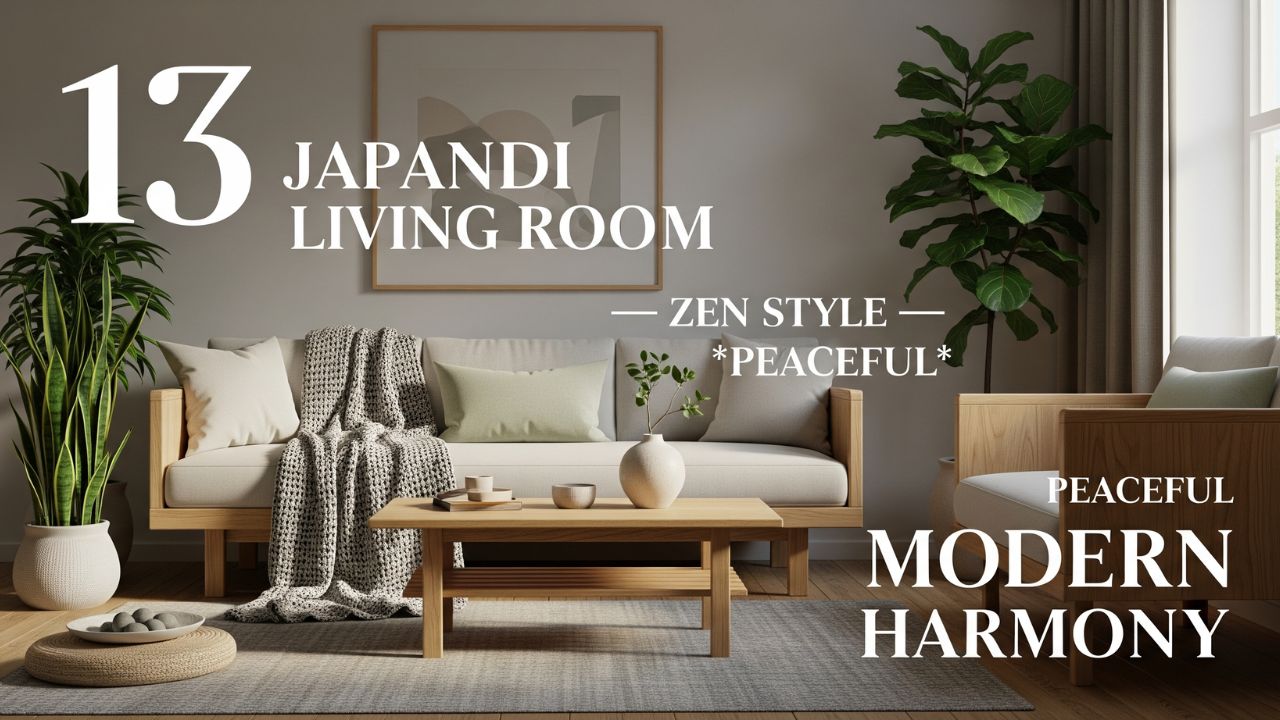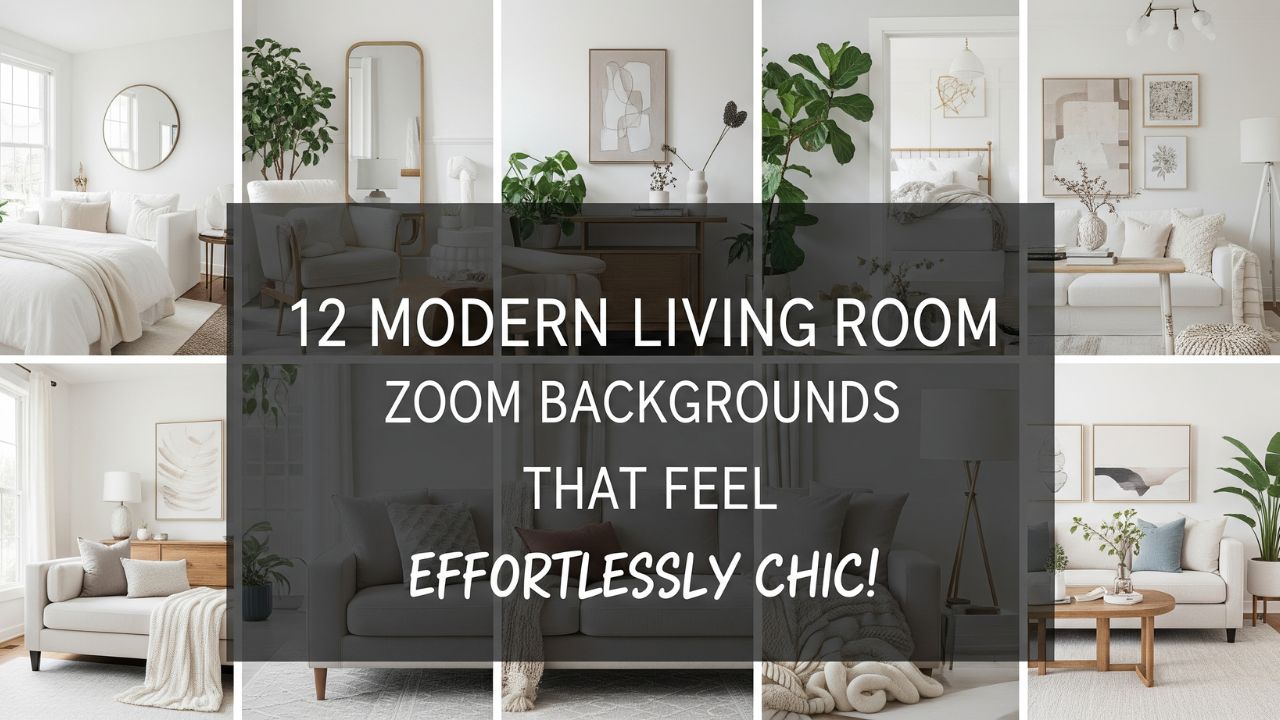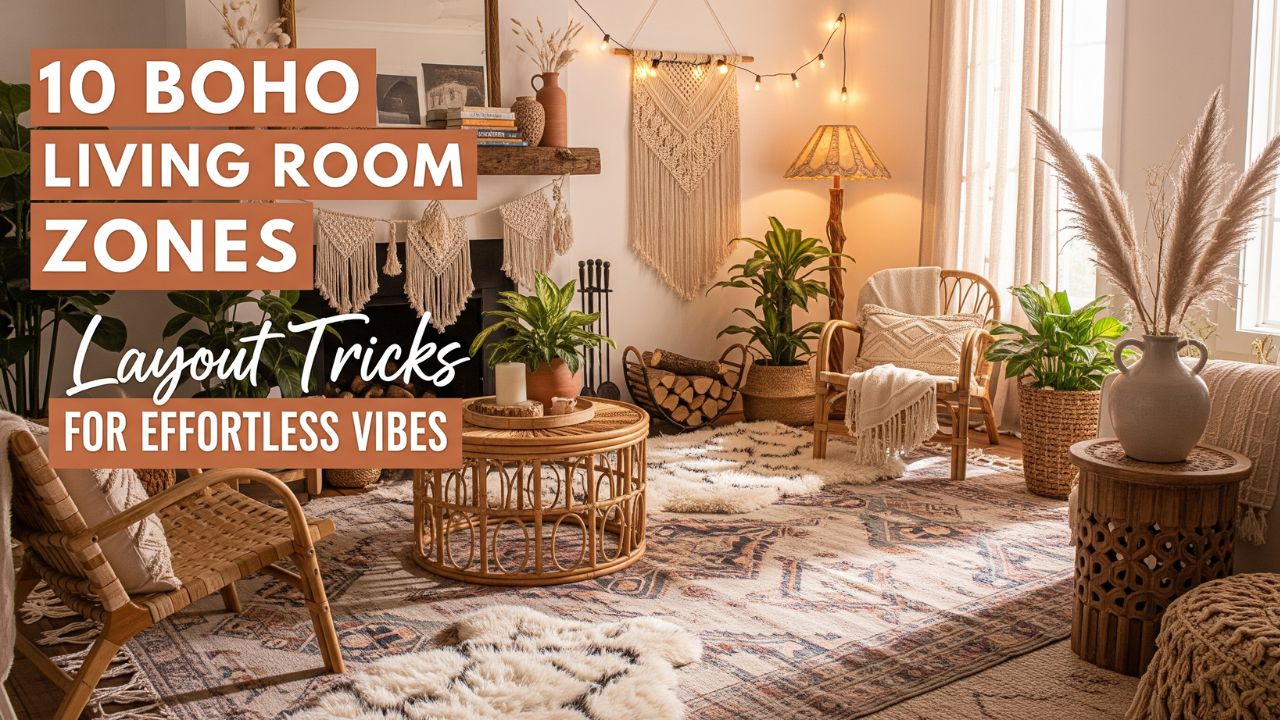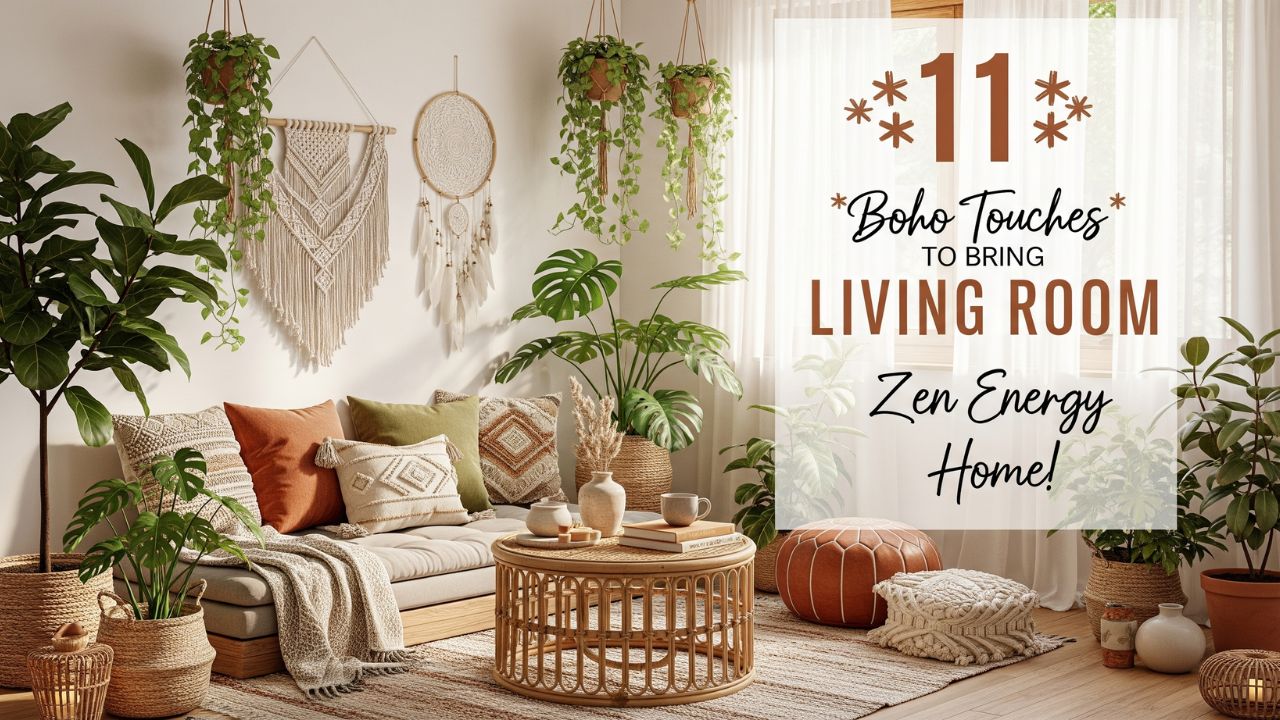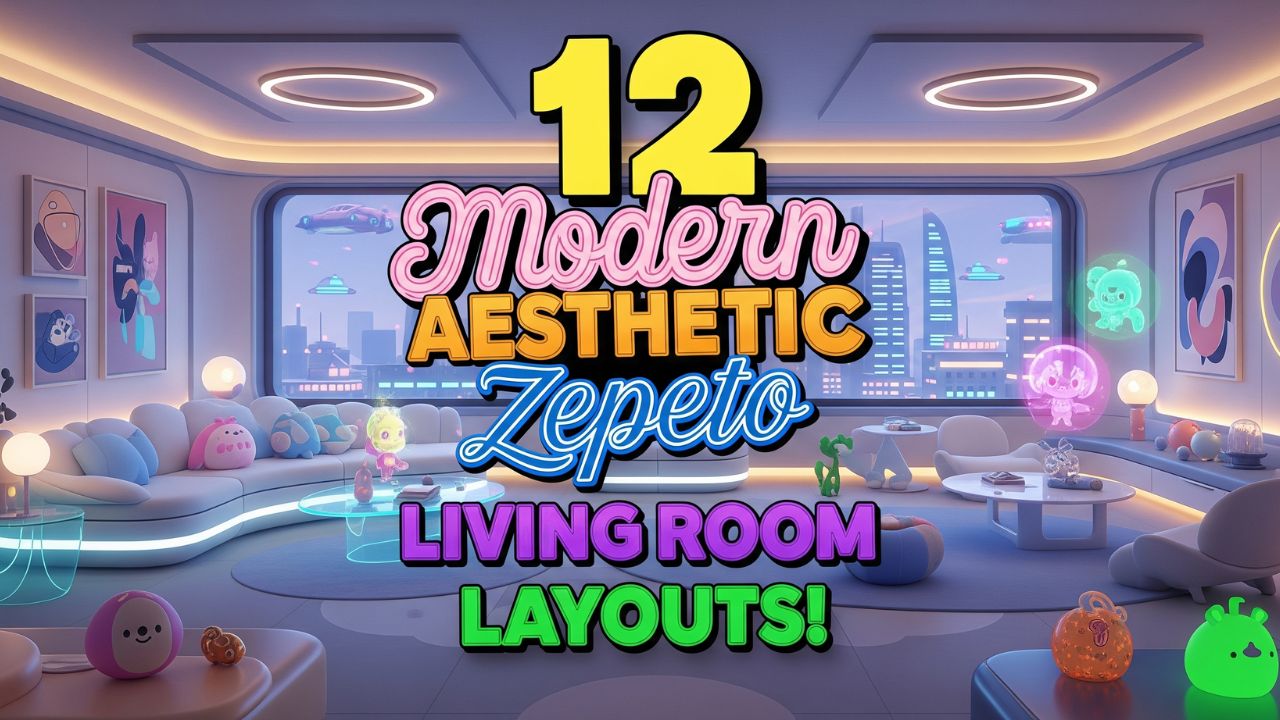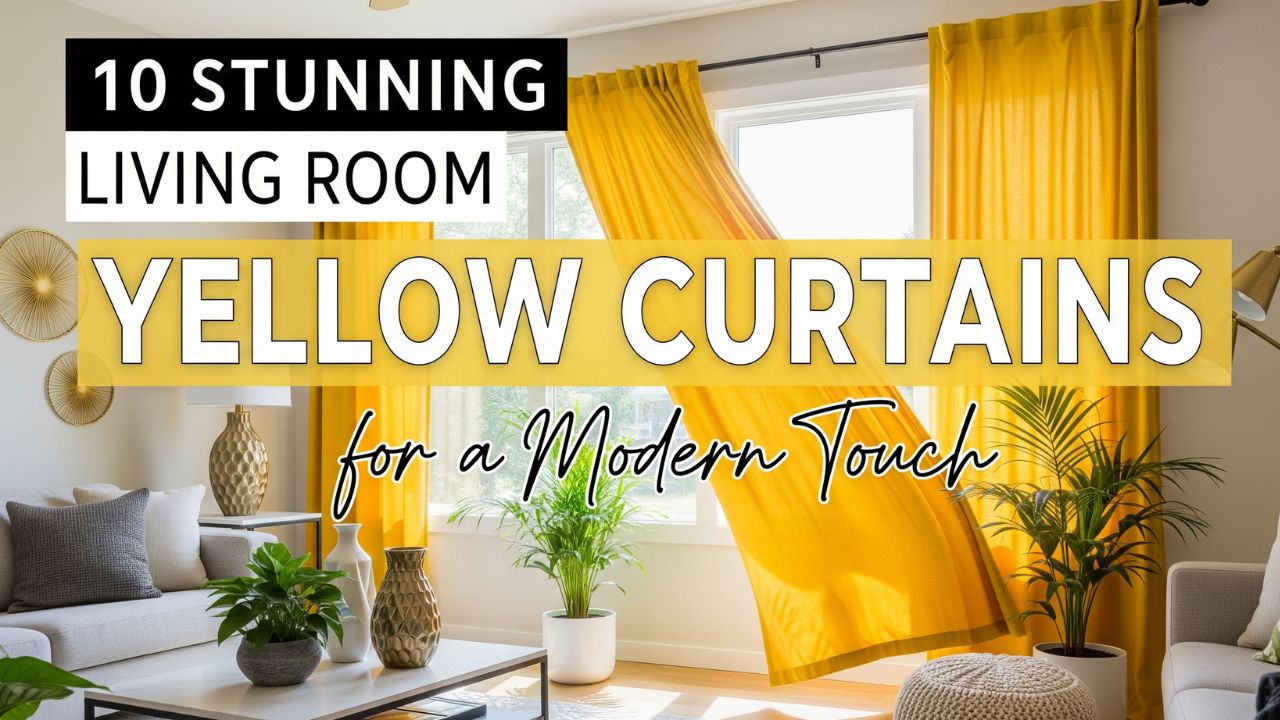Do you know that the average person spends over four hours a day in the living room—and almost all of it facing the TV? Yet, most people overlook the one element that defines the entire room’s mood — the TV unit design.
The Japandi style, a fusion of Japanese minimalism and Scandinavian functionality, is redefining how modern homes approach design. It’s calm, intentional, and deeply aesthetic — blending natural textures with sleek functionality.
If you’ve ever wanted your living room to feel effortlessly elegant yet soothing — this guide is your roadmap. Let’s explore nine stunning modern TV unit design ideas that capture the essence of Japandi serenity while keeping your entertainment setup practical and stylish.
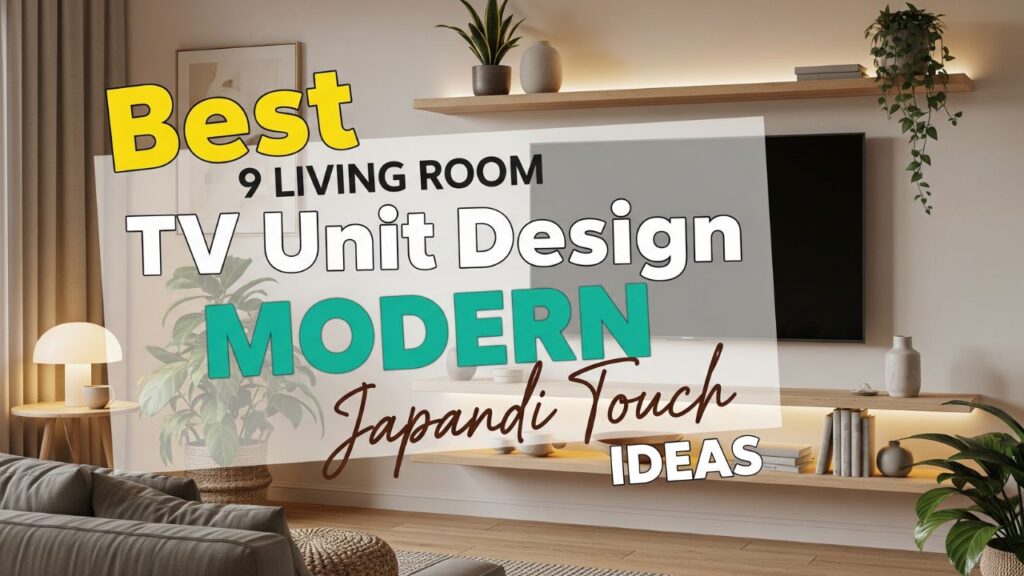
Table of Contents
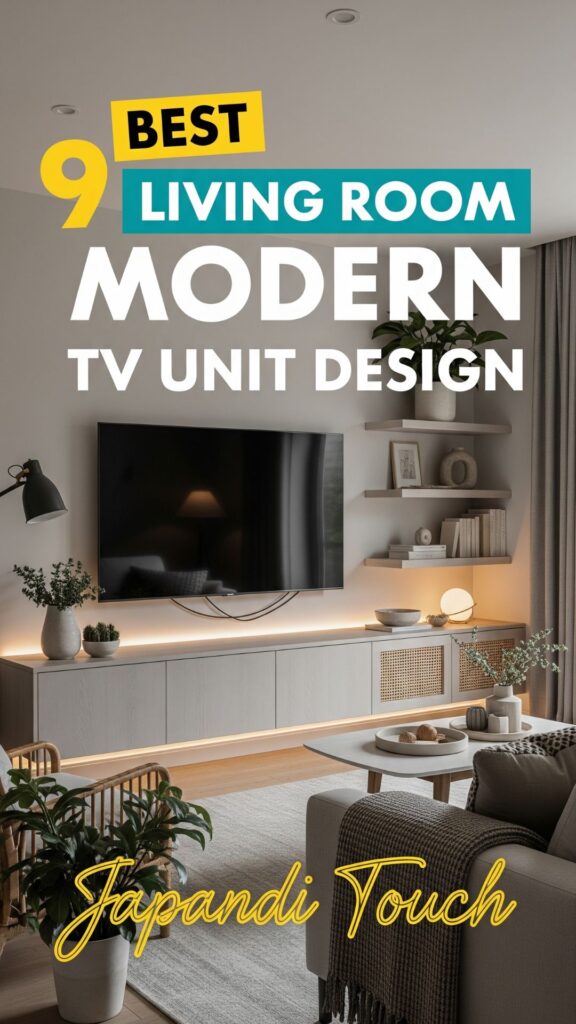
9 Living Room TV Unit Design with Japandi Touch
1. Floating Minimalist TV Unit
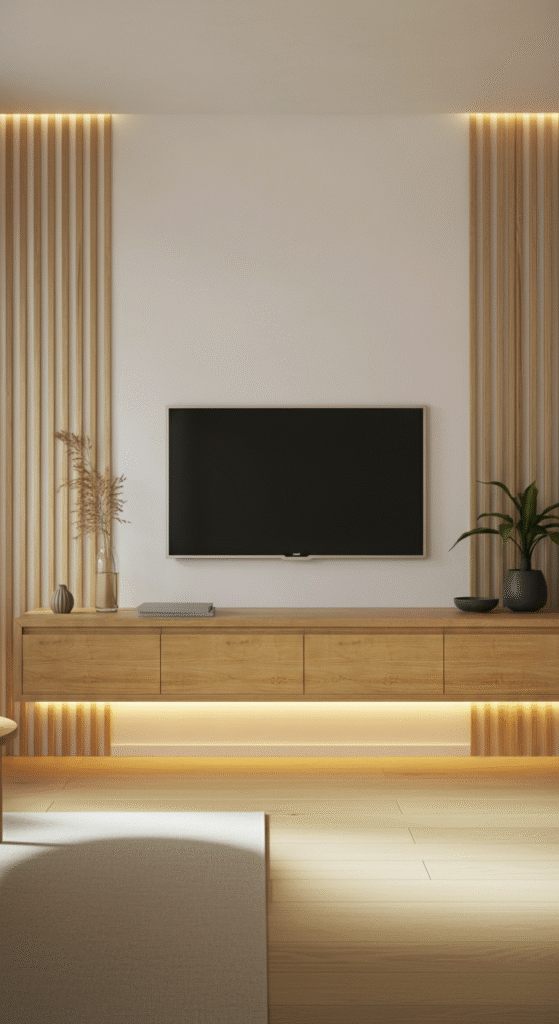
A floating TV unit embodies the true Japandi spirit — “less, but better.” Mounted directly on the wall, it creates a sense of space, perfect for compact or open-plan living rooms.
Opt for light oak, birch, or ash wood tones with smooth matte finishes. Keep visible hardware minimal and integrate cable management channels for a clutter-free look.
Design Tip: Pair it with soft LED strip lighting underneath to create a floating illusion at night. The subtle glow mimics Japanese lantern aesthetics and adds warmth without overpowering the simplicity.
Interesting Fact: The concept of floating furniture comes from Japanese architecture, designed to make small rooms appear larger and more peaceful.
2. Natural Wood Texture Meets Matte Black
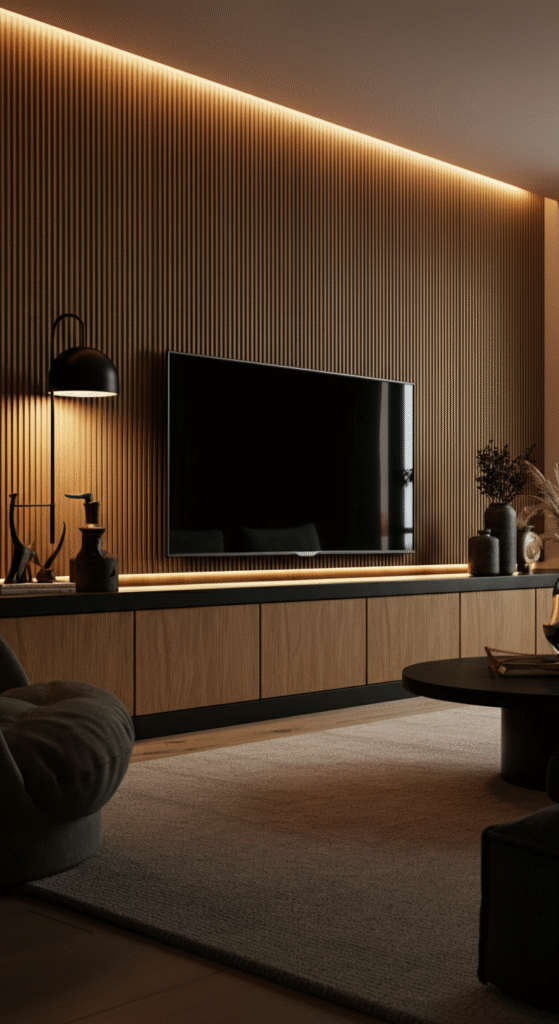
The contrast between organic wood grains and matte black surfaces brings modern Japandi balance to life. The natural texture adds warmth, while black accents ground the design with a sleek edge.
Use fluted wooden panels for texture behind the TV, and install matte black drawers beneath for storage. This pairing symbolizes harmony between nature and modern living — the core of Japandi philosophy.
Do You Know? Japanese interiors emphasize Wabi-Sabi — the beauty in imperfection. Natural wood grains, knots, and uneven tones aren’t flaws; they’re character marks that add authenticity.
3. Built-In Wall Niches with Hidden Storage
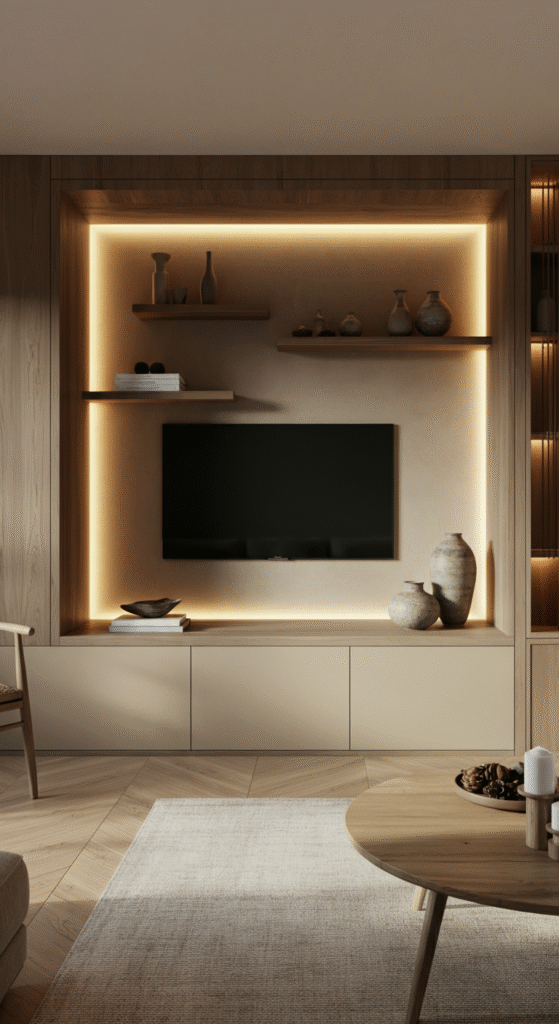
For a clean, architectural finish, integrate your TV unit into a built-in wall niche. It looks custom-made, perfectly aligned, and seamlessly merges with your living room walls.
You can create recessed shelves with LED backlighting to display ceramics, bonsai plants, or minimal decor pieces — staying true to the Japandi love for functionality and art.
Myth Busted: Many assume built-in units are expensive. In reality, modular MDF panels or laminated plywood make them affordable and easy to install with modern carpentry methods.
4. Low-Line Console with Open Shelving
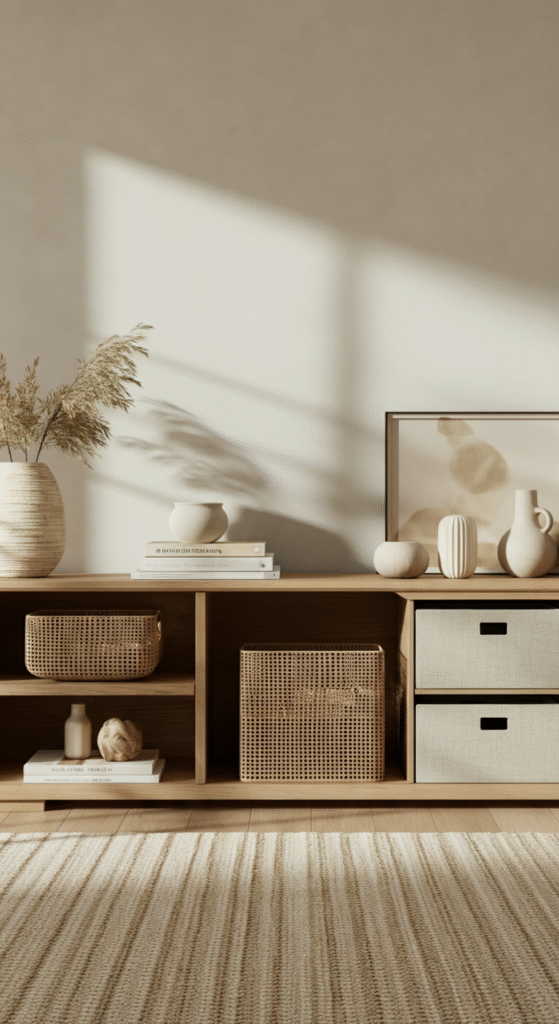
A low-profile console keeps the focus horizontal — ideal for small spaces. Combine open shelving with woven rattan baskets or soft linen drawers to introduce natural textures.
This setup gives your living room a relaxed, lounge-like appeal while offering enough space for consoles, routers, and decorative pieces.
Keep decor sparse — a few hand-thrown pottery vases or minimalist books are enough. The key lies in restraint — a Japandi principle that elevates simplicity into elegance.
Pro Insight: Scandinavian design emphasizes “visual balance.” A low console prevents top-heavy layouts, making the entire wall appear calm and cohesive.
5. Sliding Shoji-Style Doors
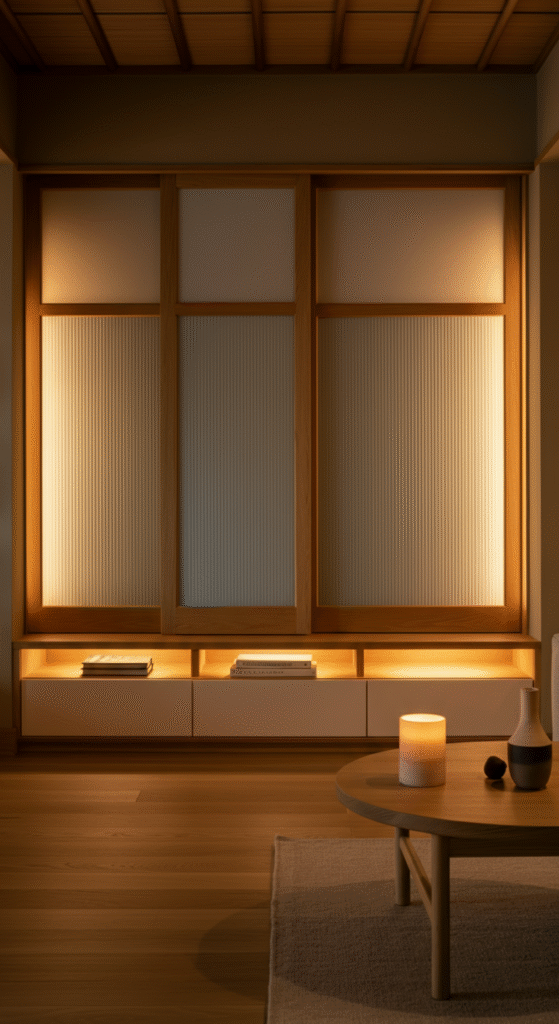
Bring the soul of traditional Japan into your modern home with sliding Shoji-inspired panels. Use frosted glass, rice paper textures, or translucent acrylic to cover the storage sections of your TV unit.
The sliding mechanism saves space while giving you flexible access — ideal for minimalist interiors. Pair it with light oak frames or soft pastel laminates to keep the aesthetic clean and calm.
Do You Know? Shoji screens originated in Japan during the 10th century and were designed to diffuse sunlight softly, creating a warm, serene glow indoors — perfect for cozy evenings.
6. Stone and Wood Fusion Wall
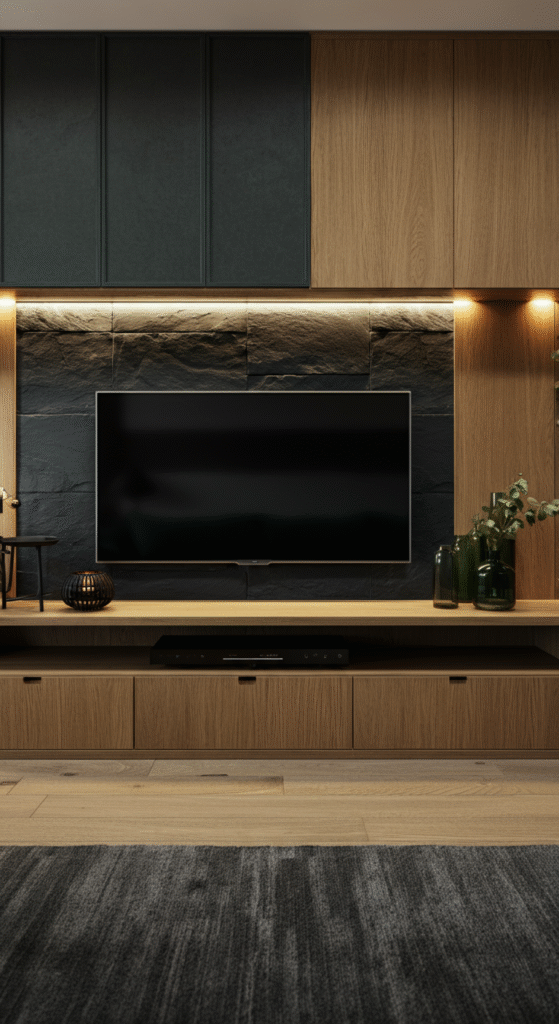
Combine natural stone textures like slate or marble with warm wood tones for a luxurious yet grounded look. The stone backdrop adds depth and durability, while the wooden cabinet below keeps the warmth alive.
This design fits perfectly in modern living rooms where contrast and texture play key roles. Keep decor minimal — a statement vase, a framed print, or a single bonsai plant works best.
Interesting Fact: Scandinavian and Japanese interiors both embrace biophilic design — connecting humans with nature through natural materials. Stone and wood are timeless symbols of this philosophy.
7. Asymmetrical Open Display Shelves
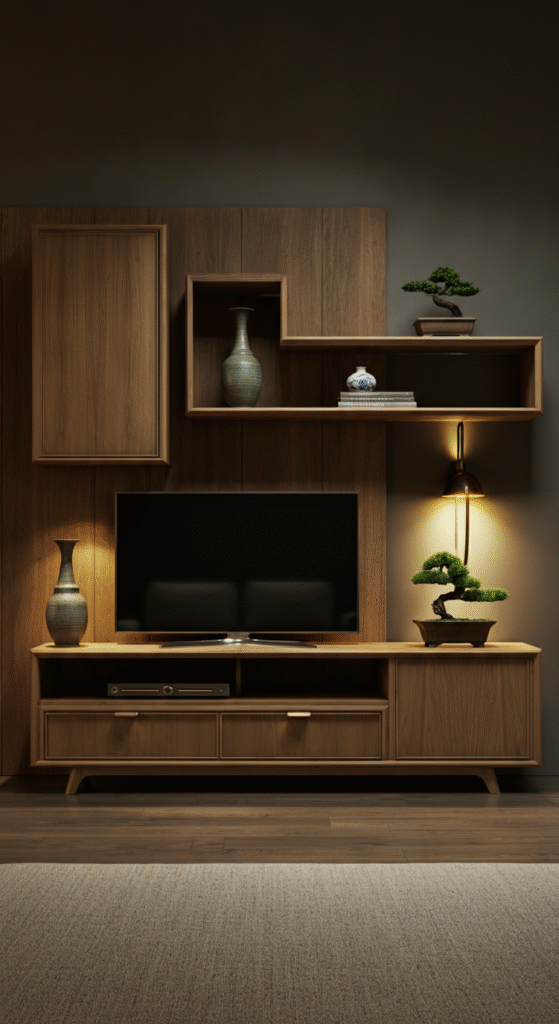
Japandi design celebrates balance through asymmetry — not everything has to be perfectly centered. Consider a TV unit where one side extends into open shelves, breaking the monotony.
Use the extra space to display curated items: ceramic bowls, woven baskets, or small plants. Each piece should have meaning — quality over quantity.
Design Note: Avoid cluttering shelves. Japanese interiors follow “Ma,” the concept of intentional empty space that allows the eye — and the mind — to rest.
Do You Know? Scandinavian interiors use a similar principle called Lagom — meaning “just the right amount.” Both cultures value moderation over excess.
8. Floating Panels with Concealed LED Backlighting
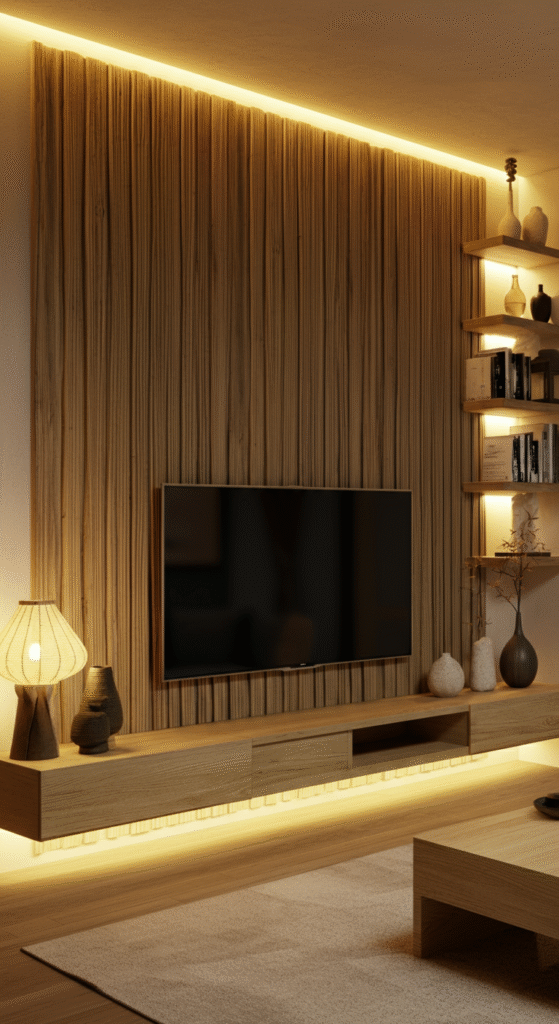
A wall-mounted TV with backlit floating panels creates a halo effect that enhances depth and mood. Choose soft white or warm light to maintain Japandi calmness — never harsh blue tones.
Panels can be made of light plywood, cork, or textured bamboo sheets. Integrate invisible brackets for a clean, floating appearance. The hidden LED backlight mimics sunrise and sunset tones — essential for a relaxing visual rhythm.
Interesting Fact: Research shows that soft indirect lighting reduces eye strain and improves perceived luxury in interior environments.
9. Compact Modular Design for Small Spaces
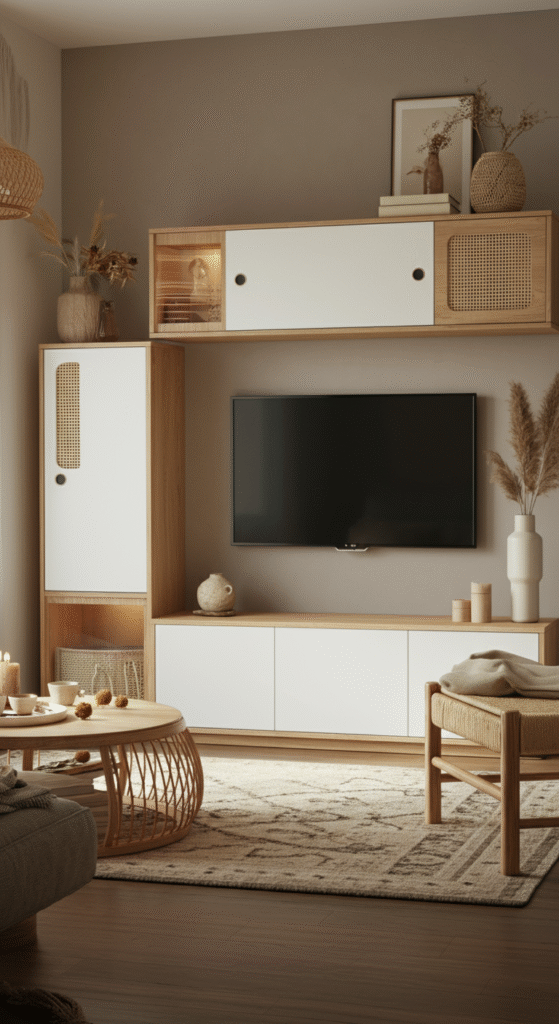
Not every home has the luxury of space — but with modular TV units, you can still embrace Japandi harmony. Choose stackable open-and-closed modules that adapt to your needs.
Mix natural wood cubes with white or beige cabinets to maintain lightness. Keep the upper wall plain to balance the proportions.
Add tactile accents like linen runners or jute decor on top of the console for that organic warmth. This approach proves that simplicity doesn’t require large spaces — just thoughtful design.
Myth Busted: Small living rooms can’t look high-end — false. Strategic use of neutral tones, symmetry, and negative space can make compact areas feel open and serene.
Bonus Tip: Integrating Nature into Your TV Wall
To complete the Japandi aesthetic, bring nature indoors. Add a small potted plant beside your TV console — bamboo, snake plant, or bonsai.
Even a vertical plant wall behind the TV can act as a natural sound absorber while enhancing tranquility.
Do You Know? Studies in Japan and Denmark have both shown that natural indoor elements reduce stress levels by over 30% — proving that beauty and wellness go hand in hand.
Conclusion: Balance Is the New Luxury
In a world of visual clutter and constant noise, Japandi-inspired TV unit designs are more than a style — they’re a lifestyle choice. They teach you to live with intention, design with purpose, and embrace the quiet beauty of simplicity.
Each of these nine ideas brings balance between modern functionality and timeless serenity. Whether you choose floating shelves, stone accents, or Shoji-style panels, remember this: the best design isn’t the one that shows off, but the one that makes you feel at peace.
Your living room deserves to be more than a space to watch — it should be a space to breathe.
Frequently Asked Questions (FAQs)
What defines a Japandi-style TV unit?
Japandi combines Japanese minimalism and Scandinavian simplicity — focusing on clean lines, natural materials, and calm, balanced design.
Which materials work best for Japandi TV units?
Use light woods like oak or ash, neutral laminates, rattan, bamboo, and matte finishes to keep the look warm yet minimal.
Can Japandi design work in small living rooms?
Absolutely. Floating units, modular setups, and low consoles create openness and maximize floor space without feeling crowded.
What colors fit Japandi interiors?
Stick to neutral tones — beige, cream, soft gray, white, and light wood. Add small black or dark gray accents for contrast.
How do I decorate around a Japandi TV unit?
Keep decor intentional — pottery, linen fabrics, small indoor plants, and warm lighting. Avoid clutter to preserve calmness.
